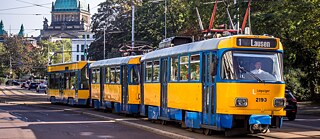Germany’s Train Station of the Year
The most impressive way to enter the city is by train. With a size of approximately 80,000m² and 24 platforms, Leipzig’s Hauptbahnhof (central train station) is the largest terminal station in Europe. Inaugurated in 1915, the train station was extensively renovated in the 1990s. A state-of-the-art shopping mall with more than 140 stores was built below the concourse. In 2011 Leipzig Central Station was voted “German Train Station of the Year”.
Trade Fairs Made-to-Measure
Leipzig has been staging trade fairs for more than 800 years. Before the fall of the wall the fairs were one of the most important meeting places for businessmen and politicians from both sides of the Iron Curtain. After the reunification of Germany the halls of the trade fairs have been renovated and still host important and popular fairs like the Leipziger Buchmesse – the second largest book fair in Germany.
From Physicist to German Chancellor
The University of Leipzig is one of the oldest universities in the world and has enjoyed over 600 years of uninterrupted teaching and research. Famous alumni include the playwright Johann Wolfgang von Goethe, the composer Richard Wagner, the philosopher Friedrich Nietzsche, the German Chancellor (and physicist) Angela Merkel and multiple Nobel Prize winners in Physics, Chemistry and Literature. Today, more than 40,000 students and more than 1,000 scientists call Leipzig their home.
The Peaceful Revolution
The “Monday Demonstrations” were the beginning of the peaceful protest that caused the collapse of East Germany and led to the reunification of Germany – and they began in Leipzig in the fall of 1989. Their slogan “We are the people” expressed the repression the people of East Germany felt under the communist regime. The idea of the demonstrations emerged in the church services of the Nikolaikirche (St. Nicholas Church), a meeting point for reform-minded citizens.
City of Music
Composers like Johann Sebastian Bach, Richard Wagner and Felix Mendelssohn who all lived in Leipzig have shaped the city’s image as a center of classical music. The building that best represents this tradition is the concert hall “Gewandhaus” which hosts one of the oldest symphony orchestras of the world, the “Gewandhausorchester”. More interested in contemporary music? Bill and Tom Kaulitz, members of the band Tokio Hotel, were born in Leipzig in 1989.
Leipzig Goes Black
For four days every spring Leipzig becomes the Wave-Gothic Capital of the World. Thousands of Goths covered in tons of eyeliner and makeup and sporting shiny jewelry and extreme piercings turn Leipzig into a dark fantasy realm. All music genres of the Goth world play at the “Wave-Gothik Treffen”, from Trad to EBM and from Goth Metal to Neo-Folk. In addition to the concerts there are all-night dance parties, readings, theater performances and a medieval market.
Where Goethe and Faust drank
“Auerbachs Keller” (i.e. Auerbach’s Cellar) is one of the oldest and best-known restaurants in Germany – it was first mentioned in 1438. It owes much of its fame to the playwright Goethe, who frequented Auerbach’s Cellar as a student and called it his favorite wine bar. According to legend, the alchemist Dr. Faust once rode a wine barrel from the cellar to the street, something he could have accomplished only with the help of the Devil. This legend is most likely what led Goethe to add the scene in Auerbach’s Cellar to his play Faust I.
The World's Largest Freestanding Advent Calendar
Erected for the first time in December 1997, the world’s largest freestanding advent calendar is one of the major attractions of Leipzig Christmas market. At a mammoth 9,400 square feet the calendar is the largest of its type in the world and has entered the Guinness Book of Records. One giant door is opened at 4.30pm every day until Christmas Eve, when the final door is opened at 11am.
Soccer with Energy
Soccer in Leipzig has a long tradition. The German Football (Soccer) Association (DFB) was founded in Leipzig in 1900. VfB Leipzig won the first national championship in 1903. In 1956, the Zentralstadion opened, at the time the biggest stadium in Europe being able to hold 100,000 spectators. Today, energy-drink producer Red Bull is the sponsor of RB Leipzig, the only team in the Bundesliga representing a city from the former East Germany.
